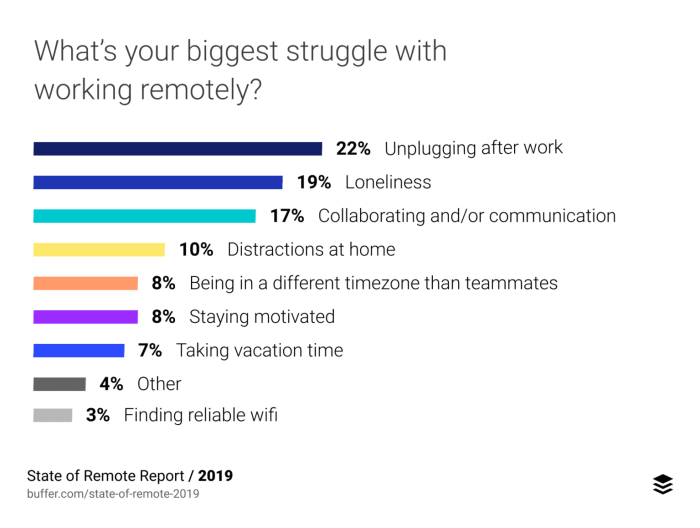Remote Work Productivity sets the stage for a discussion on how working remotely can boost efficiency and flexibility, revolutionizing the traditional work environment.
From the benefits to the challenges and strategies, this topic delves into the essentials of thriving in a remote work setting.
Benefits of Remote Work Productivity
Remote work offers numerous advantages that can significantly boost productivity. One key benefit is the flexibility it provides to employees, allowing them to work at their own pace and schedule. This can lead to increased motivation and efficiency as individuals can choose the times when they are most productive.
Enhanced Efficiency
- Remote work eliminates time-consuming commutes, allowing employees to start their workday promptly and reduce distractions.
- With the ability to create a personalized work environment, individuals can optimize their workspace for maximum productivity.
- Remote work encourages better work-life balance, reducing burnout and improving overall focus and concentration.
Impact of Flexibility
- Flexible work hours enable employees to align their tasks with their peak energy levels, resulting in higher quality work.
- Remote work allows individuals to take breaks when needed, leading to improved mental health and reduced stress levels.
- The option to work from anywhere increases job satisfaction and loyalty, contributing to higher productivity levels.
Challenges of Remote Work Productivity
Remote work offers flexibility and convenience, but it also comes with its own set of challenges that can hinder productivity. From dealing with distractions to maintaining a healthy work-life balance, remote workers face unique obstacles that require proactive strategies to overcome.
Distractions While Working Remotely
One of the biggest challenges remote workers face is the abundance of distractions in their home environment. Whether it’s noisy neighbors, household chores, or constant notifications on their devices, staying focused on work can be a struggle.
- Set up a dedicated workspace free from distractions to create a productive environment.
- Establish a daily routine and schedule to maintain focus and stay on track with tasks.
- Use productivity tools and apps to block distracting websites and manage time effectively.
Importance of Work-Life Balance in Remote Work Productivity
Another challenge remote workers often face is finding the right balance between work and personal life. Without clear boundaries, it’s easy to overwork or feel burned out, leading to decreased productivity and satisfaction.
- Set specific work hours and stick to them to create a separation between work and personal time.
- Take regular breaks throughout the day to recharge and avoid burnout.
- Engage in activities outside of work, such as exercise or hobbies, to maintain a healthy work-life balance.
Tools and Technologies for Remote Work Productivity

In today’s digital age, there are a plethora of tools and technologies available to enhance remote work productivity. These tools facilitate effective collaboration, communication, and project management for remote teams.
Essential Tools for Effective Remote Collaboration and Communication
- 1. Communication Platforms: Utilize tools like Slack, Microsoft Teams, or Zoom for real-time messaging, video conferencing, and file sharing.
- 2. Collaboration Tools: Platforms such as Google Workspace, Microsoft 365, or Trello enable seamless collaboration on documents, spreadsheets, and projects.
- 3. Virtual Whiteboards: Tools like Miro or MURAL allow team members to brainstorm, plan, and collaborate visually in real-time.
How Project Management Tools Improve Productivity in Remote Teams
- Project management tools like Asana, Jira, or Monday.com help remote teams stay organized, track progress, assign tasks, and set deadlines efficiently.
- These tools provide transparency, accountability, and visibility into project timelines, milestones, and individual responsibilities, fostering productivity and collaboration.
The Role of Virtual Meeting Platforms in Enhancing Remote Work Productivity
- Virtual meeting platforms such as Zoom, Microsoft Teams, or Google Meet facilitate seamless communication, collaboration, and engagement among remote team members.
- These platforms enable face-to-face interactions, screen sharing, and recording capabilities, replicating the experience of in-person meetings and enhancing team cohesion.
Strategies for Managing Remote Work Productivity

When it comes to managing remote work productivity, there are several key strategies that can help you stay focused and efficient in your work. From setting up a conducive workspace to effective time management techniques, these strategies can make a significant difference in your remote work experience.
Setting Up a Productive Remote Workspace
- Designate a specific area in your home for work, separate from your personal space.
- Ensure your workspace is well-lit, organized, and free from distractions.
- Invest in ergonomic furniture to promote good posture and reduce physical strain.
- Add personal touches like plants or artwork to make the space more inviting and inspiring.
Time Management Techniques for Remote Workers
- Create a daily schedule or to-do list to prioritize tasks and stay on track.
- Use time-blocking to allocate specific time slots for different activities throughout the day.
- Take regular breaks to avoid burnout and maintain productivity levels.
- Utilize productivity tools like task management apps or Pomodoro technique to enhance time management skills.
Maintaining Motivation and Focus while Working Remotely, Remote Work Productivity
- Set clear goals and objectives for each workday to stay motivated and focused on tasks.
- Avoid multitasking and focus on one task at a time to improve concentration and efficiency.
- Stay connected with colleagues through virtual meetings or chats to combat feelings of isolation.
- Reward yourself for achieving milestones or completing tasks to boost motivation and morale.